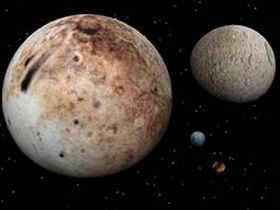
Pluto is classified as a dwarf planet, making it one of the most remote objects in the Solar System. It is situated approximately 5900 million kilometers away from the Sun and completes one orbit around the celestial body in 247.7 years.
Presentation: The Planet Pluto
* Correction to the video presentation: The New Horizons spacecraft has now completed its exploration of Pluto
Pluto has a relatively compact size, with a diameter of approximately 2390 kilometers. The estimated density of this celestial object is between 1.5 and 2.0 grams per cubic centimeter. In terms of mass, Pluto is considerably smaller than other planets, with a mass that is only 0.002 times that of Earth. Furthermore, astronomers have determined that a single day on Pluto is equivalent to 6.9 Earth days.
Structure within
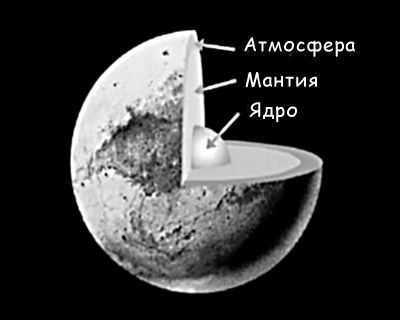
Due to its significant distance from Earth, Pluto remains a planet that has not been thoroughly investigated. As a result, scientists and astronauts can only make educated guesses about its internal makeup. Officially, it is believed that the planet is primarily composed of frozen gases, such as methane and nitrogen. This conclusion is based on spectral analysis carried out in the late 1980s. However, there are indications that Pluto may have a core, potentially comprised of ice, as well as an icy mantle and crust. The main elements found on Pluto are water and methane.
Atmosphere and surface
The atmosphere and surface of the planet are closely interconnected. The atmosphere is composed of various gases, including nitrogen, oxygen, carbon dioxide, and trace amounts of other gases. These gases create the air we breathe and play a crucial role in regulating the planet’s temperature and climate.
The surface of the planet is made up of land, water, and ice. The land consists of various types of terrain, including mountains, plains, and deserts. Water covers approximately 71% of the planet’s surface and is found in the form of oceans, seas, rivers, and lakes. Ice is primarily found in the polar regions and on mountaintops.
The atmosphere and surface interact in numerous ways. For example, the atmosphere affects the surface through weather patterns, such as wind and precipitation. It also acts as a protective shield, filtering out harmful radiation from the sun. On the other hand, the surface influences the atmosphere through processes like evaporation, which adds moisture to the air.
Understanding the complex relationship between the atmosphere and surface is crucial for studying and predicting changes in our planet’s climate. Scientists use various tools and techniques, such as satellites and weather stations, to monitor these interactions and gather data that can inform our understanding of the Earth’s systems.
In conclusion, the atmosphere and surface of the planet are intricately linked and have a significant impact on each other. Studying and preserving these interconnected systems is vital for maintaining the health and stability of our planet.
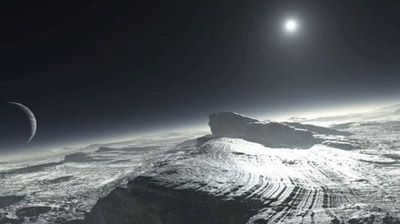
Pluto, the solar system’s ninth largest planet, possesses its own unique atmosphere, rendering it inhospitable to any form of life. This atmosphere comprises carbon monoxide, methane gas, which is extremely light and soluble in water, and significant quantities of nitrogen. With an average temperature of around -220 °C, Pluto is an incredibly frigid planet. Additionally, its infrequent proximity to the Sun, occurring only once every 247 years, causes a portion of the ice covering its surface to convert into gas, resulting in a further temperature decrease of 10 °C. Consequently, the temperature of the celestial body’s atmosphere fluctuates within the range of -180 °C.

The surface of Pluto is coated in a dense layer of ice, primarily composed of nitrogen. It is also recognized for its flat landscapes and rugged cliffs made up of the same ice mixture. The south and north poles of Pluto are perpetually covered in snow.
The Moons of Pluto
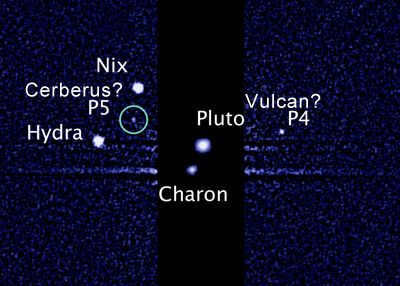
Pluto, a distant planet in our solar system, was originally believed to have only one natural satellite called Charon. However, further examination of images taken by the Hubble telescope in 2005 revealed two additional satellites, later named Hydra and Nycta. In 2011, a fourth satellite was discovered and given the temporary designation P4, followed by the discovery of a fifth satellite, P5, in 2012. As of 2013, we now know of a total of five satellites orbiting Pluto.
It has been discovered that Charon was created from the debris expelled from the planet, and it orbits alongside other significantly smaller moons of Pluto.
Fascinating information about the celestial body

Pluto is classified as a distinct dwarf planet within our solar system, although there is ongoing debate among astronomers regarding this classification. This celestial object is situated in the Kuiper belt, a region predominantly composed of sizable asteroids and dwarf planets that contain volatile substances such as water and various types of rocks. Consequently, some scientists argue that it would be more appropriate to refer to Pluto as an asteroid rather than a planet, as it is traditionally known. Since 2006, Pluto has been officially designated as a dwarf planet.
Exploring the World
Astronomers made the relatively recent discovery of Pluto in 1930, with its satellite Charon following in 1978. Other satellites, such as Hydra, Nycta, P4, and P5, were discovered even more recently, just a few years ago. The original suggestion of a celestial object in the Kuiper Belt came from American astronomer Percival Lovell way back in 1906. However, the technology available in the early 20th century was not advanced enough to accurately determine its precise location. While Pluto was first captured in a photograph in 1915, the image was too faint for scientists to give it any recognition.
Today, the credit for discovering Pluto is attributed to Clyde Tombaugh, an American astronomer who had been studying asteroids for many years. Tombaugh was the first person to capture a high-resolution image of Pluto, earning him an award from the Astronomical Society of England.
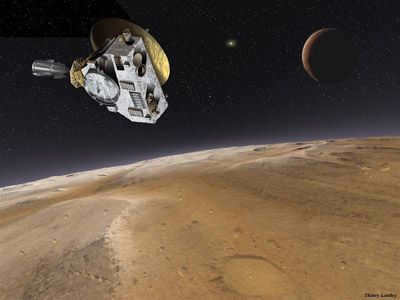
Pluto has historically received less attention in comparison to other planets, despite some attempts to explore this faraway celestial body (which is nearly 40 times farther from Earth). Scientists have generally prioritized the study of celestial bodies with a higher likelihood of supporting life, such as Mars.
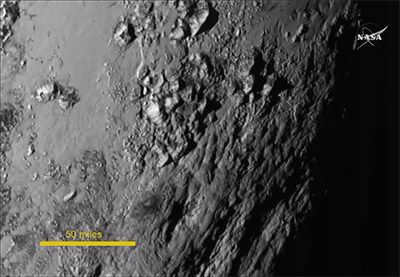
(New Horizons captured a close-up image of Pluto’s surface, revealing its plains and mountains.)
The New Horizons mission, which is expected to last 15-17 years, is one of the longest space journeys. Notably, the New Frontiers spacecraft holds the record for the highest altitude achieved by any automated station. Throughout its extensive journey, the spacecraft conducted studies of Jupiter, transmitting numerous groundbreaking images, and successfully crossed the orbit of Uranus. After its exploration of the dwarf planet Pluto, New Horizons continued its mission to explore the distant objects of the Kuiper belt.
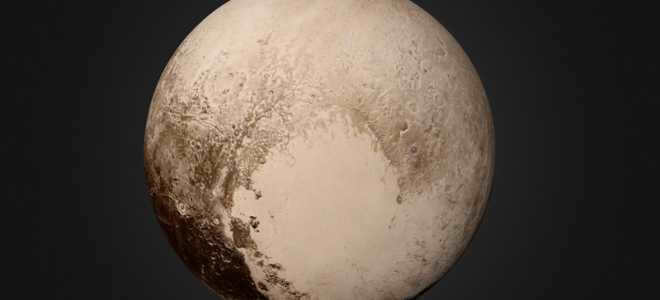
In our solar system, there is a dwarf planet known as Pluto, which is the largest in its category. It was first discovered on February 18, 1930, through photographic observation and the study of celestial bodies.
Previously, Pluto was considered the ninth planet of the solar system. However, in 2006, its status was reclassified as a dwarf planet and a transneptunian object.
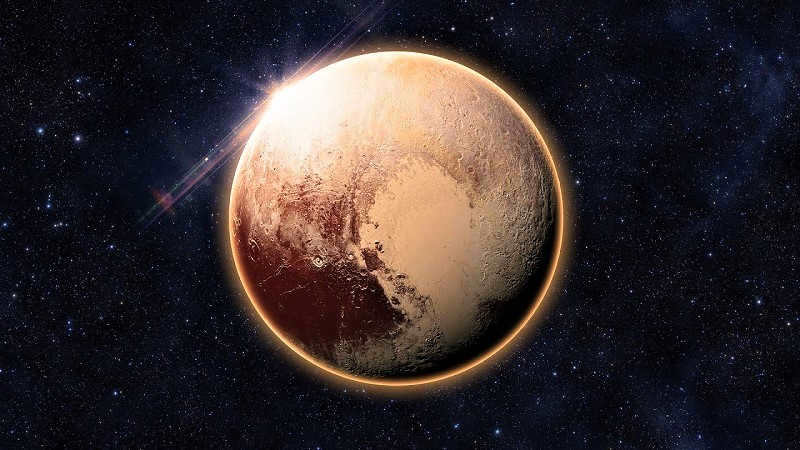
Transneptunian objects are celestial bodies that make up the Kuiper belt, the diffuse disk, and the Oort cloud.
What sets dwarf planets apart from regular planetary bodies? For one, they have less mass. Additionally, they lack gravitational dominance, meaning they are unable to clear their orbital area of other bodies that do not fall within their gravitational influence. In other words, they cannot dispose of objects that are not their natural companions.
Because Pluto has a lower mass and lacks dominant gravity, it is classified as a dwarf planet. Despite this, it still possesses certain planetary characteristics such as a large satellite and an atmosphere. It turns out that this phenomenon is not uncommon among transneptunian objects.
What are the characteristics of Pluto?
First and foremost, Pluto is composed of a solid core and a frozen mantle that is approximately 300 km thick. In terms of structure, it can be divided into three main components: rocky material, water ice, and frozen nitrogen mixed with methane and carbon monoxide. Interestingly, the amount of water ice on Pluto is much greater than what can be found in Earth’s oceans. Additionally, spectral analysis reveals that the upper region of Pluto is predominantly made up of volatile ice, particularly nitrogen ice.
Pluto has a mass of 1.303*10^22 kilograms, making it about six times smaller than our Moon. Its volume is also three times smaller than the Moon’s. However, despite its smaller size, Pluto has a density of 1.860 g/cm^3.
When considering only the celestial bodies orbiting the Sun, Pluto ranks tenth in terms of mass.
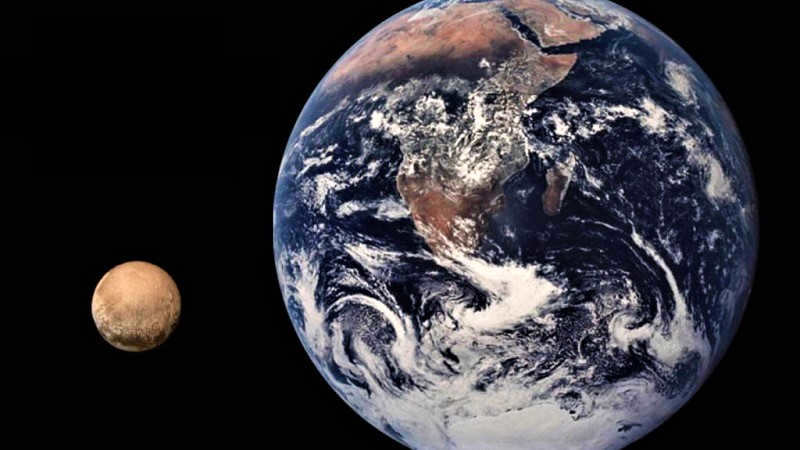
Based on modern calculations, Pluto has a diameter of 2376 kilometers. Additionally, its total area is equivalent to 17.7 million square kilometers, slightly larger than the territory of the Russian Federation.
Interestingly, in terms of mass and size, Pluto is not only smaller than regular planets, but also some of their moons. However, it remains the largest object in the trans-Neptunian region and the second heaviest in the scattered disk, following Erida.
Analysis of images and photographs reveals that Pluto’s shape is not flattened like most celestial bodies, and its surface is heterogeneous and non-uniform. It is covered by an icy crust and exhibits noticeable variations in brightness and darkness, as well as the presence of craters.
Pluto’s Orbit and Rotation
Pluto stands out from other planets due to its unique orbit characteristics. It has a significant inclination of 17.14 degrees to the ecliptic plane and a large eccentricity of 0.2488. As a result, its distance from the Sun can vary greatly, ranging from 4.4 billion kilometers to 7.4 billion kilometers.
The sizable eccentricity has an impact on Pluto’s position in relation to the Sun and other planets. Periodically, one side of Pluto is closer to the Sun than Neptune, creating a unique scenario. This occurred, for instance, from February 1979 to February 1999. Despite this, the orbital inclination prevents the ecliptic plane from intersecting with Neptune’s orbit.
Scientists can predict the motion of Pluto’s orbit millions of years into the past and future.
Calculating the exact distance between Pluto and Earth is a challenging task, let alone comprehending it. The estimated distance is believed to be 4.4-7.29 billion kilometers, and a day on Pluto lasts 6.387 Earth days.
Interestingly, Pluto and Neptune are in a unique orbital resonance known as a 3:2 resonance. This means that while Neptune takes 247.92 Earth years to complete one orbit around the Sun, Pluto completes three. Additionally, Pluto’s rotation on its axis is similar to that of Venus and Uranus, as it spins in the opposite direction compared to other celestial bodies in relation to the Sun.
Atmosphere
It should be mentioned that the atmosphere of the planet is significantly tenuous and is composed of gases that are released from the icy surface. Primarily composed of nitrogen with traces of methane and carbon monoxide. Furthermore, the intense radiation leads to the formation of additional intricate compounds, such as ethylene, ethane, and acetylene. Eventually, these compounds reach the surface, which likely accounts for the existence of a stratified haze at an elevation of approximately 200 kilometers.
The pressure in the atmospheric layers is extremely low and subject to significant fluctuations. In an ideal scenario, the eccentricity of the orbit would result in substantial atmospheric changes as the planet moves further away from the Sun. However, observations indicate that the pressure actually increases as the planet moves farther from the star. This phenomenon is likely influenced by the fact that during this time, Pluto’s north pole emerges from the shadow cast by the Sun, leading to the evaporation of nitrogen from the polar cap.
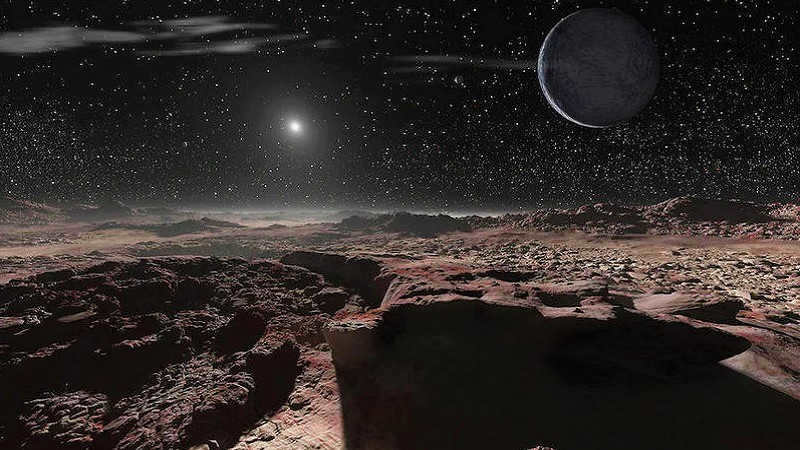
It appears that the temperature rises as you go higher in altitude. On the surface, the average temperature is -223.15 degrees Celsius, while in the atmosphere it is 40 degrees warmer. This difference is due to the greenhouse effect, which is caused by the presence of methane.
However, the low atmospheric pressure helps to balance out the daily temperature variations in the surface layers.
What are the satellites of the planet Pluto?
Pluto has a total of five natural satellites. The first one discovered was Charon, which is the largest and closest to Pluto.
In addition to Charon, scientists discovered Nycta and Hydra in 2005, Kerber in 2011, and Styx in 2012. All of these satellites orbit in the equatorial plane of Pluto and have almost circular orbits. Their direction of motion is the same as Pluto’s rotation axis. Additionally, they are all in orbital resonance, with their orbital times having a ratio of 1:3:4:5:6.
The satellites, except for Charon, have irregular shapes and have a bright diffuse surface reflectivity. It’s important to note that the satellite system only occupies a small fraction of the possible volume.
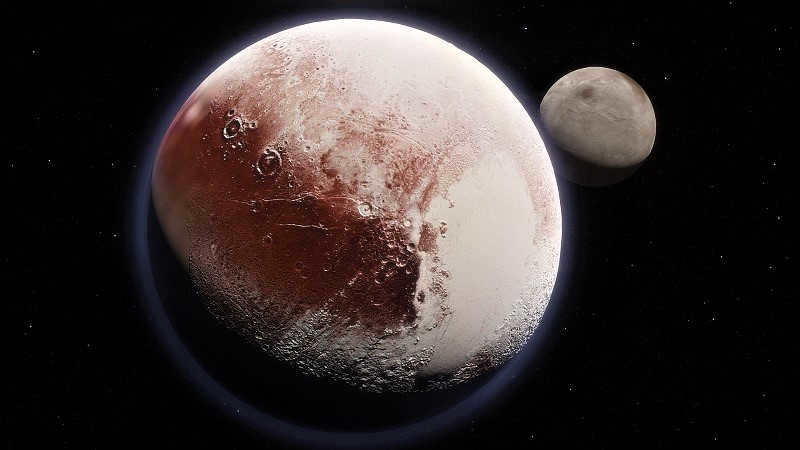

Fascinating details about Pluto

- Undoubtedly, the most remarkable aspect is the reclassification from planet to dwarf celestial body and transneptunian object. It took a considerable amount of time to comprehend and grasp its true nature.
- As early as 1950, Soviet scientists postulated that Pluto belongs to the group of dwarf planets. However, the evidence to support this hypothesis emerged in the XX-XXI centuries. During that time, numerous previously unknown objects within the solar system were unearthed. For instance, Erida, which boasts a greater mass than that of Pluto, or Sedna.
- Moreover, there exists an extremely feeble magnetic field.
- The gravitational acceleration in free fall amounts to 0.658 m/s2.
- The mean stellar magnitude is 15.1, signifying that it can only be detected with high-powered telescopes.
- It boasts a light brown complexion.
- Pluto and Charon are perceived as a binary system due to the fact that their barycenter lies outside of both bodies. Conceivably, in the future, the International Astronomical Union will introduce the notion of binary dwarf planets. Nonetheless, Charon is officially acknowledged as a satellite.
- The radioactive chemical element plutonium bears his name.
The center of mass of bodies that revolve around each other is called the barycenter.
What lies ahead for Pluto
Based on the theory of stellar evolution, the brightness of the sun increases as time goes on. Eventually, the habitable zone of the entire solar system will gradually move away from Earth’s orbit. Scientists predict that the sun will evolve into a red giant. There is a possibility that celestial objects in the Kuiper Belt, where Pluto is located, could provide suitable conditions for the existence and sustenance of life.
In reality, this planet is challenging to explore due to its significant distance from Earth. It was only in 2015 that we were able to gain more knowledge about it, thanks to the images captured by the New Horizons spacecraft. As we are aware, scientific and technological advancements are constantly evolving. Perhaps, one day, the vast expanse of space will no longer be as distant and enigmatic to us.
Therefore, we have now discovered which celestial body is no longer classified as a planet and the reasons behind it. We have also obtained information about Pluto and its key characteristics.

Pluto was once considered a planet in our solar system, but in 2006 it was reclassified as a dwarf planet. This celestial object is located beyond Neptune, making it a transneptunian object. Pluto’s orbit is known for its high eccentricity and inclination to the ecliptic plane.
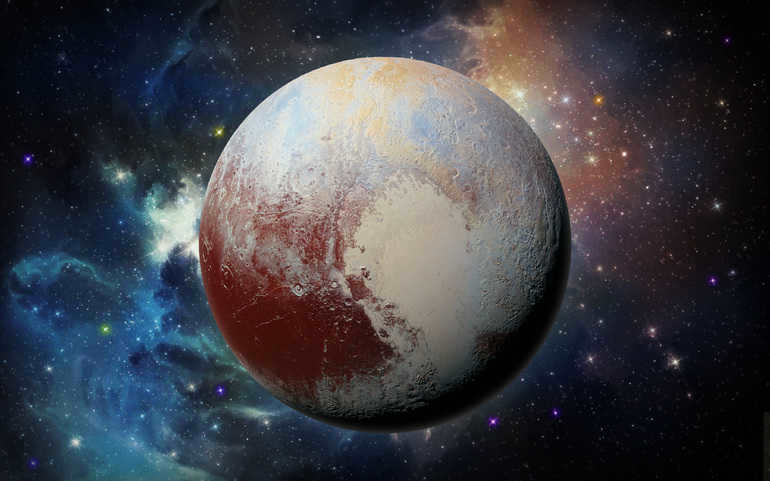
Discovery History
In the middle of the 1800s, a French mathematician named W. Leverrier used classical mechanics based on Newton’s laws to predict the existence of Neptune. Leverrier’s predictions were based on the perturbations in the orbit of Uranus. By the end of the 19th century, scientists had reached a consensus that Uranus was being influenced by another planet. At the start of the 20th century, an American astronomer named P. Lowell set out to find this mysterious planet, which he referred to as “Planet X”. Lowell calculated potential locations within the solar system where this new celestial body could be located. However, Lowell was unable to make the discovery himself as he passed away in 1916.

After three years following his passing, astronomers were fortunate enough to capture images of Pluto on four photographic plates. However, during this time, the planet was situated at a great distance and was barely visible. The search for Pluto was put on hold for several years. It was only in 1929 that the director of the observatory, Slifer, instructed the newcomer, K. Tombaugh, to resume the search. To accomplish this, the young specialist conducted nightly surveys of the starry sky. During these surveys, he carefully observed each section three times with a few days in between. Using a blink comparator, Tombaugh was able to gather information about celestial bodies that exhibited changes in their positions.
Just one year later, he successfully spotted a celestial object that traversed the celestial expanse. In March of 1930, word of Pluto’s detection was sent via telegraph to the Harvard College Observatory, and Tombaugh was honored with the Hannah Jackson-Gwilt Medal.
Choosing the Name
As the individuals responsible for the discovery of the planet were affiliated with the esteemed Lowell Observatory, they were granted the privilege of naming the recently discovered celestial body. The observatory extended an invitation for people worldwide to submit their suggestions, resulting in an influx of letters from all corners of the globe. Among the proposals was the name “Pluto” put forward by an 11-year-old student from Oxford named V. Burney. Apart from her keen interest in astronomy, the young girl had a passion for studying ancient mythology, leading her to believe that the name of the Greek god would be a fitting choice for the new planet.

The staff of the observatory was given the task of selecting a more appropriate name (Minevra, Kronos, Pluto) for the celestial object. Following a brief deliberation, the name of the Greek deity was unanimously chosen and was formally announced in print on May 1, 1930.
Physical attributes
Because of the substantial distance separating Earth from Pluto, conducting a comprehensive examination of the planet is exceedingly challenging. The most recent and extensive data was acquired relatively recently, when the man-made satellite New Horizons successfully reached the vicinity of the celestial object. Here is a rundown of the physical characteristics of the planet:
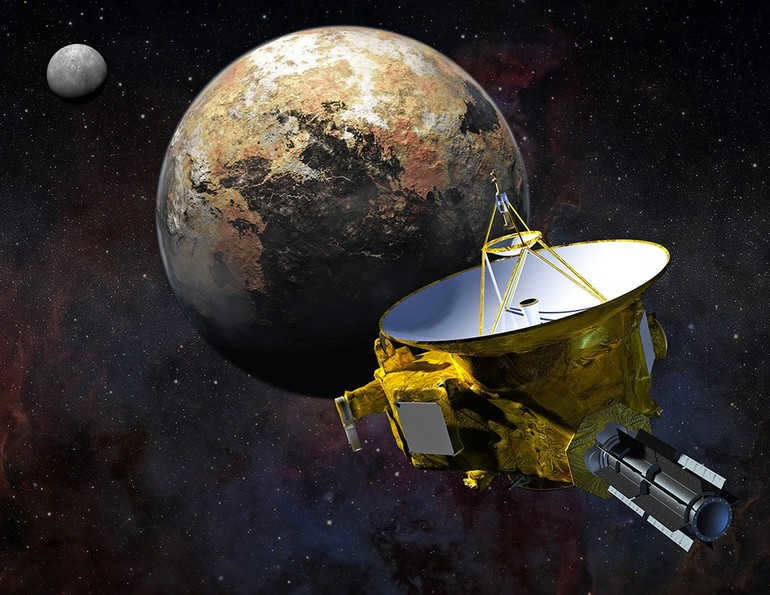
- The equatorial and polar radii of Pluto are 1153 km;
- Its total area is approximately 1.6697-10 7 km²;
- Pluto has a mass of (1.305 ± 0.007)-10 22 kg;
- The planet’s first space velocity is 1.23 kilometers per second;
- It completes a full revolution in 6.39 days;
- Pluto has a stellar magnitude of up to 13.65;
- The free-fall acceleration on Pluto is 0.658 m/s² (0.067 g).
Due to its small angular diameter of about 0.11″, Pluto is extremely challenging to observe even with a powerful telescope. It appears as a regular star, with only albedo details visible in images captured by the Hubble Space Telescope.
Description of the Planet’s Structure
From the images captured during the eclipse of Pluto by its companion, it is evident that the surface of this transneptunian object displays a reddish hue and unevenness. As a result, the planet’s brightness and spectrum undergo periodic changes during its rotation.
The high density of this celestial body suggests that it is composed of approximately 50-70% rock and 30-50% ice. Pluto’s geological makeup consists of a solid rocky core encompassed by a layer of ice, which is approximately 300 km thick. On the surface of the planet:
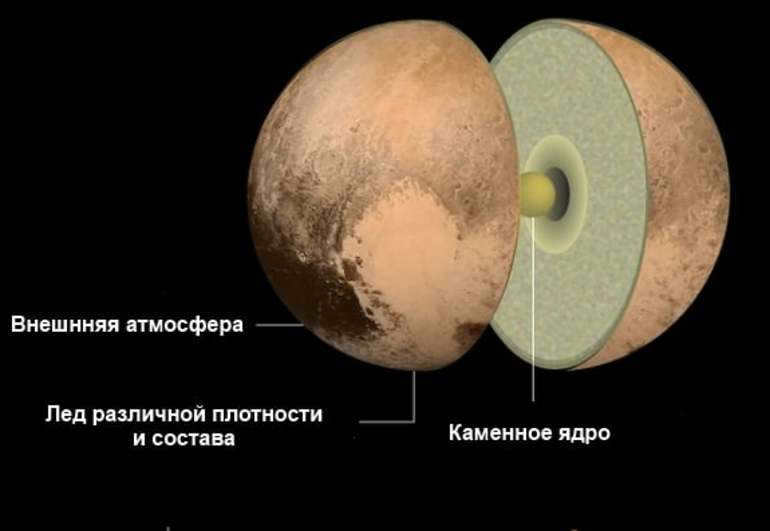
- 97-98% of the ice on Pluto is nitrogen that can easily evaporate;
- There is also frozen methane, which makes up 1.5-3% of the ice;
- carbon monoxide is present in the ice in small amounts, ranging from 0.01-0.5%;
- Various other chemical compounds can also be found in the ice.
These substances exist in a volatile state, meaning they can change from solid to gas depending on the season and move across the surface. In 2015, images revealed the presence of mountains as high as 3.5 kilometers above the icy surface, which are likely composed of ice. There is also a large, light-colored area in the shape of a heart. Furthermore, Pluto has its own atmosphere, which consists of:
The rest of the atmosphere is primarily made up of a combination of nitrogen and carbon. The density and temperature of the atmosphere change depending on the distance from the Sun, and when Pluto moves far away, the atmosphere becomes completely extinct.
Moons of Pluto
Pluto has a total of five moons, with the largest one being Charon. Charon was first discovered in the 1970s and has a diameter of 1212 km, which is about 35% the size of the Moon. The other moons were discovered much later, thanks to the Hubble telescope. All of Pluto’s moons orbit in the same direction and have nearly circular orbits. In terms of their arrangement relative to Pluto, they follow this sequence:
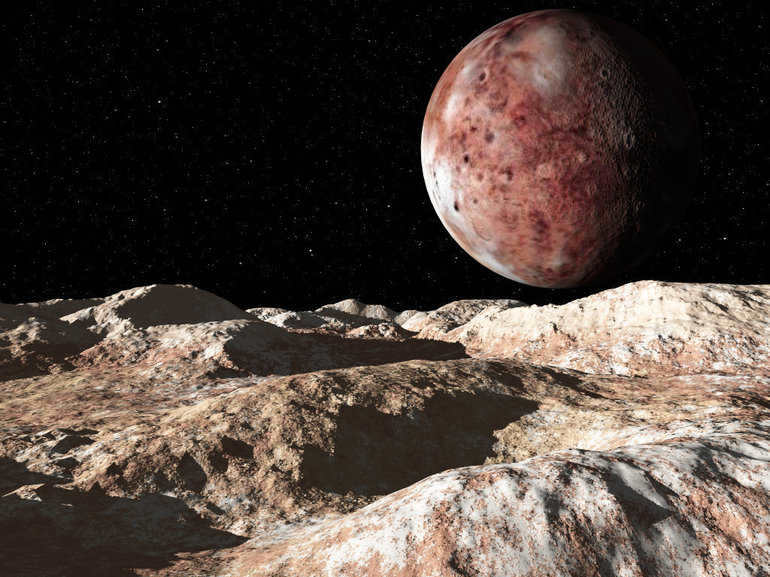
Pluto and its moons are categorized as a dwarf planet. They take up a relatively small amount of space, with the farthest moon having a maximum orbital radius of 2.2 million km. Although the moons have irregular shapes, they have a high albedo of 0.5 due to the cleaner ice on their surfaces. Scientists speculate that the presence of these small moons indicates that Pluto may also have rings, potentially formed by the impact of meteorites and asteroids.
Exploration of Outer Space
The majority of the planet’s exploration has been conducted using the renowned Hubble Telescope from the United States. It wasn’t until the early 21st century, when the government provided funding, that the New Horizons spacecraft was sent on a mission to study Pluto. In January 2006, the Atlas 5 rocket was launched to propel the spacecraft into space.
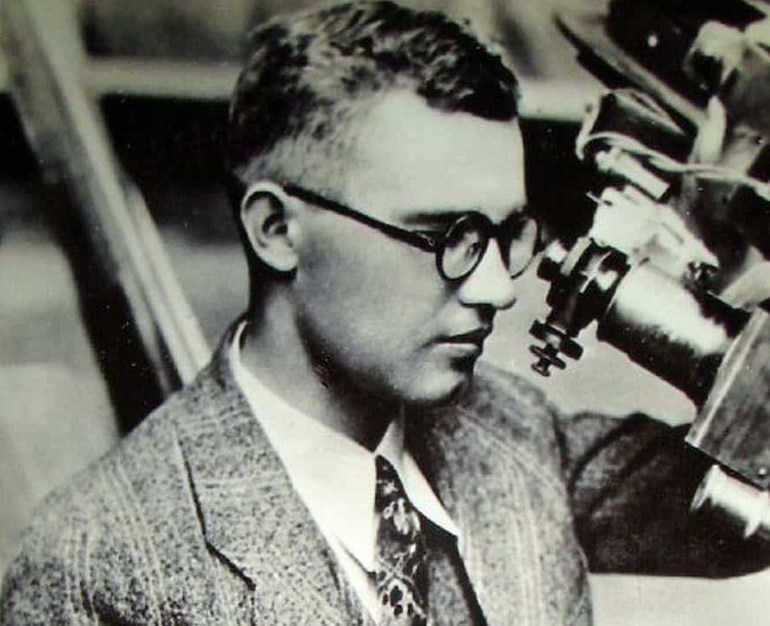

Furthermore, a portion of the remains of C. Tombaugh, who passed away in the late 20th century, were interred on the spacecraft. Exactly one year later, while passing by Jupiter, the spacecraft received an additional boost in speed – its intended destination was Pluto in 2015. Special equipment was installed onboard the spacecraft, and as a test for the camera, the first photograph was taken over 4.2 billion kilometers away from the planet.
Interesting information
Despite being discovered in 1930, there remains a dearth of knowledge about the enigmatic planet. Pluto remains largely uncharted by humanity, yet there exist numerous captivating tidbits about this celestial body. Some of these intriguing facts are:
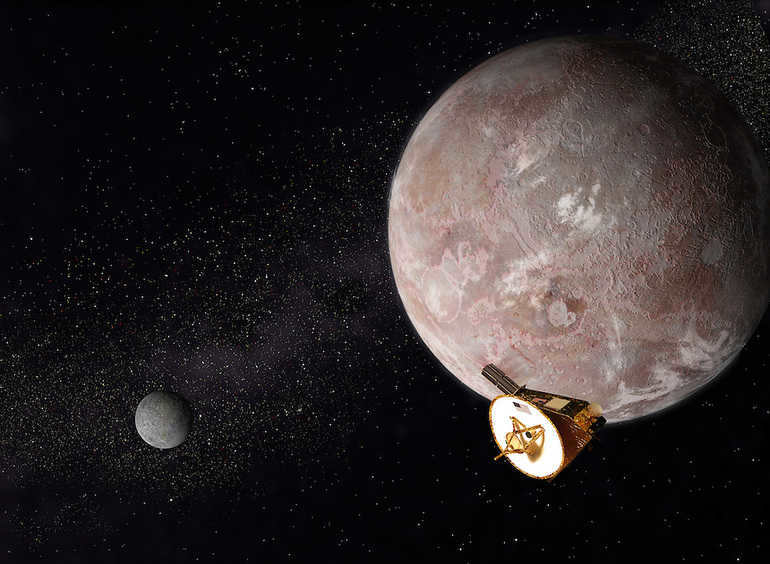
- It takes 248 years for a complete orbit to be made by Pluto.
- By analyzing the physical parameters of Pluto, scientists decided in 2006 to exclude it from the group of planets and classify it as a dwarf planet instead.
- The orbit of this transneptunian object is the most elongated.
- Pluto’s atmosphere is not suitable for sustaining life.
- It takes almost seven days for Pluto to complete one revolution around its axis.
- The sun appears to move from west to east on Pluto.
- Pluto rotates in the opposite direction compared to Earth.
- The average surface temperature on Pluto is -229 °C.
- Pluto is considered the second smallest trans-Neptunian object in terms of size.
- The element plutonium is named after Pluto.
- Pluto’s orbital cycle will conclude in 2178 since its discovery.
- When seen from the Sun’s surface, it will appear as a tiny speck.
- Pluto weighs six times less than the Moon.
- It is believed that both Pluto and its moon Charon share the same atmosphere.
NASA specialists are currently analyzing the latest photos sent by the New Horizons station. It is possible that humanity will soon gain new insights about Pluto.
Many individuals have recollections from their time in school that there are a total of 9 planets located within our solar system. The initial planet that is situated closest to the Sun is Mercury. Conversely, Pluto is the farthest planet from the Sun. However, at present, the number of planets in our solar system is not 9, but rather 8. In the year 2006, Pluto was officially eliminated from the roster of planets in the solar system and was instead classified as a dwarf planet. The reasoning behind this change can be attributed to the International Astronomical Union (IAU), who declared that any object classified as a planet within the solar system must meet three specific criteria:
- The object must possess a spherical shape.
- The object must orbit around the Sun.
- The object must have cleared its orbital path of other celestial bodies. In other words, the planet must have a gravitational dominance and there should be no other celestial bodies of similar size in the vicinity, with the exception of its satellites.
In 2015, the New Horizons spacecraft journeyed to Pluto, capturing images of the planet and enabling the scientific community to conduct a more detailed study of it.
Today, we have prepared not only a brief overview, but also some captivating facts about this remarkable dwarf planet.
№1
The dwarf planet Pluto was officially discovered by American astronomer Clyde William Tombaugh in 1930 at the Lowell Observatory in Flagstaff, USA. At that time, Pluto was recognized as an official member of the solar system’s planets. Tombaugh’s announcement led other astronomers to review their archives, revealing that the planet had been observed on at least 12 previous occasions, though no one had ever suspected it was a planet.
An interesting fact about the name of Pluto is its origin. The name “Pluto” was actually coined by a young girl named Venetia Burney, who was only 11 years old at the time. Venetia suggested the name to her grandfather, Falconer Madan, who happened to work at Oxford University’s Bodleian Library. Her grandfather then passed on the suggestion to Herbert Hohl Turner, an astronomy professor, who eventually shared it with his colleagues at the Lowell Observatory.
No. 2
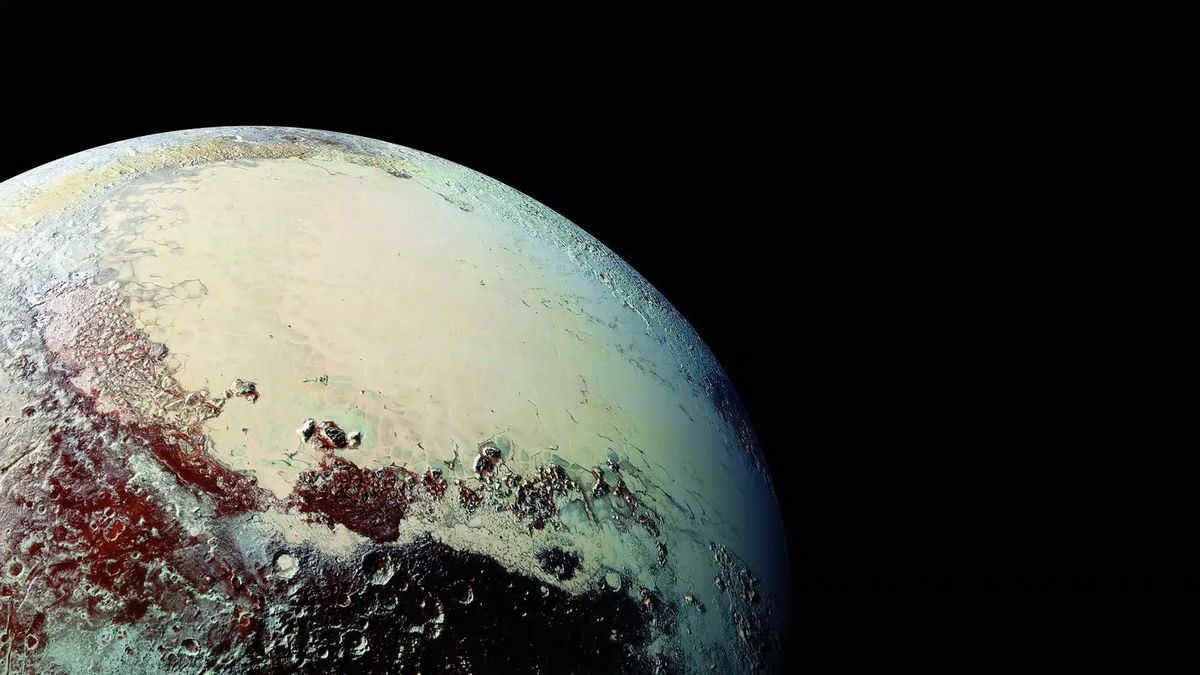
Prior to being removed from the list, it was recognized as the tiniest planet within the solar system. With a diameter of 2,370 kilometers, it is roughly one-fifth the size of Earth or two-thirds the size of the Moon.
Being located at such a great distance from the Sun, this celestial body has not had the opportunity to complete a full revolution around its star since its initial identification. The completion of its orbit takes approximately 247.68 years, which is a significant span of time. Given that less than a century has elapsed since its initial discovery, it is understandable why this celestial object has not yet completed a full orbit around the Sun.
№4
Small celestial bodies typically cannot develop an atmosphere due to their weak gravitational pull. Pluto, however, defies this norm as it possesses its own atmosphere. This atmosphere is primarily composed of nitrogen, although it is considered incomplete and “temporary”. When Pluto approaches the Sun, the ice on its surface begins to evaporate, leading to the creation of a transient atmosphere. As Pluto moves further away from the Sun, this atmosphere dissipates.
№5
It is surprising that a planet as small as Pluto has a total of five satellites. The reason behind this high number of satellites is the fact that Pluto is located on the outskirts of the Kuiper belt, a region that lies at the farthest distance from our solar system. This area is filled with numerous icy celestial bodies and fragments that constantly orbit around Pluto, leading to the formation of new satellites.
Among these satellites, Charon is the largest one, while Hydra is the smallest. However, Hydra resembles more of an asteroid, as it only has a diameter of 8 km. The remaining three satellites are known as Styx, Nix, and Kerberos.
The surface of the dwarf planet was captured beautifully by the New Horizons spacecraft. A majority of Pluto is blanketed in a dense coating of methane ice. Additionally, a distinctive heart-shaped zone can be observed on the planet’s surface. Informally named the Tombaugh region, it is speculated that the left side of this “heart” is composed of crystalline nitrogen.
When it comes to the surface of Pluto, it is incredibly frigid, with temperatures plummeting to as low as -225 degrees Celsius.
No. 7

The orbit of Pluto is not perfect, as it is not circular but rather elliptical. Due to this, it intersects with the orbit of Neptune. Pluto, being a dwarf planet, has a slow rotation on its axis, with a day lasting approximately 6.4 Earth days.
We can assume that Pluto is in darkness, supposedly far from the Sun. However, contrary to expectations, Pluto is not as dark as it is believed to be. In fact, during the moments when the planet is fully illuminated by the Sun, it would hypothetically be possible to read a book on its surface.
№9
Thanks to the images captured by the New Horizons spacecraft, it has been discovered that certain regions of Pluto are less than 100 million years old. These areas exhibit a scarcity of meteorite impact craters and are characterized by towering mountains that reach heights of up to 3.5 kilometers. It is speculated that Pluto is still undergoing formation, resulting in ongoing changes in certain areas over time.
Number 10
Pluto and its partner Charon are in constant alignment with each other. As a result, on one side of Pluto, Charon is always visible, while on the opposite side, it is always hidden from view.
We trust that this knowledge will captivate not just youngsters, but also a mature readership.
I am a blogger and the primary author of the website Interessno.ru. Ever since I was a child, I have had a passion for reading books and acquiring knowledge in various fields. I have obtained two higher education degrees. Currently, alongside managing this online platform (as well as several others), I also work as a college professor.
I engage in sports activities and maintain a healthy lifestyle. I am always ready to lend a hand and eager to communicate. You can reach out to me via email, which is provided in the footer (bottom) section of this website.
Pluto (designated as 134340 Pluto) is the second largest dwarf planet in the solar system, following Eridas. Initially classified as the ninth planet of the solar system, it is now categorized as a Kuiper Belt object.
Pluto (Greek: Πλούτων, Latin: Pluto), also known as Ditus (Latin: Dis) or Orcus, is the ruler of the underworld in Roman mythology, similar to the role of Hades in Greek mythology.
Pluto (the dwarf planet)
Similar to other celestial bodies in the Kuiper Belt, Pluto is primarily made up of rock and ice, and it is relatively small in size: its mass is five times less than that of the Moon, and its volume is three times less. The orbit of Pluto has a high eccentricity and a significant inclination in relation to the ecliptic plane.
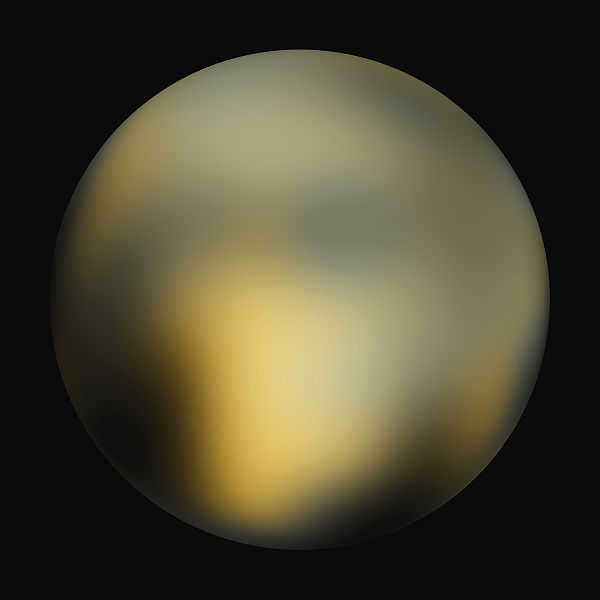
An image depicting the dwarf planet Pluto has been generated using data from the Hubble Space Telescope.
Pluto’s orbit is highly eccentric, bringing it closer to the Sun than Neptune at a distance of 29.6 astronomical units (4.4 billion kilometers), before moving away to a distance of 49.3 astronomical units (7.4 billion kilometers). Due to the positioning of their barycenter, Pluto and its largest companion Charon are often considered a double planet. The International Astronomical Union (IAU) has expressed its intention to establish a formal definition for double dwarf planets, and until then, Charon is classified as a satellite of Pluto. Additionally, Pluto has two smaller satellites named Nicta and Hydra, which were discovered in 2005.
Since its discovery in 1930 till 2006, Pluto was recognized as the ninth planet in our solar system. Nevertheless, in the late 20th and early 21st centuries, numerous celestial bodies were found in the outer region of the Solar System. Particularly noteworthy are Kvavar, Sedna, and notably Erida, which has a mass that is 27% greater than that of Pluto. The International Astronomical Union (IAU) established the definition of a “planet” for the first time on August 24, 2006. Pluto did not meet this definition, therefore the IAU classified it as a dwarf planet, along with Erida and Ceres. Following this reclassification, Pluto was included in the list of minor planets and assigned the catalog number 134340 by the Small Planet Center (SPC). However, some scientists persist in the belief that Pluto should be reclassified as a planet once again.
The Discovery of History

The Mount Wilson Observatory can also lay claim to the discovery of Pluto in 1919. During that year, Milton Humason, acting on behalf of William Pickering, was conducting a search for the ninth planet, and managed to capture an image of Pluto on a photographic plate. However, in one of the two photos, the image of Pluto coincided with a small defect in the emulsion (it almost appeared to be a part of it), and in the other photo, the image of the planet was partially overlapped by a star. Even in 1930, it was still quite challenging to identify the image of Pluto in these archival photographs.
Tombaugh was given the task of systematically capturing images of the night sky in pairs of photographs every two weeks and then comparing them to identify objects that had changed position. To facilitate this comparison, a blink comparator was utilized, which allowed for the rapid switching of the two plates, creating the illusion of movement for any object that had changed position or visibility between the photographs. After nearly a year of diligent work, Tombaugh noticed a potentially moving object in photographs taken on January 23 and 29. This observation was further confirmed by a lower-quality photograph from January 21. On March 13, 1930, after receiving additional confirming photographs, the news of the discovery was telegraphed to the Harvard College Observatory.
Appellation

The responsibility of naming the recently discovered celestial body was given to the Lowell Observatory. Tombaugh advised Slifer to complete this task promptly to avoid being beaten to it. Different suggestions for the name came pouring in from various parts of the world. Constance Lowell, the widow of Lowell, proposed the names “Zeus,” “Percival,” and her own name. However, all of these suggestions were disregarded.
The official name of the site was chosen on March 24, 1930. The members of the Lowell Observatory had the opportunity to vote for one of three options: “Minerva” (although this name was already being used for one of the asteroids), “Kronos” (which was not popular due to its association with an astronomer of ill repute named Thomas Jefferson Jackson C.), and “Pluto.” “Pluto” received the majority of the votes and the name was officially announced on May 1, 1930. Faulconer Maydan then presented Venice with a £5 prize.
The astronomical symbol for Pluto is a combination of the letters P and L, which are the initials of P. Lowell’s name. The astrological symbol for Pluto is similar to that of Neptune, but with the addition of a circle instead of the middle prong in the trident.
In Chinese, Japanese, Korean, and Vietnamese, the name of Pluto is translated as the Star of the Underground King, which was proposed by Japanese astronomer Hoei Nojiri in 1930. While some Indian languages may use the name of the god Yama (such as Yamdev in Gujarati), who is the guardian of hell in Buddhism and Hindu mythology, many other languages opt for the transliteration “Pluto” (Russian for “Pluto”).
No Planet X?
Upon the initial identification of Pluto, there were doubts regarding its classification as Lowell’s Planet X due to its faintness and lack of a distinct planetary disk. Over the course of the mid-20th century, the estimated mass of Pluto was consistently revised downward. However, the discovery of Charon, Pluto’s companion, in 1978 provided a means to accurately measure its mass. This measurement revealed that Pluto’s mass, which is approximately 0.2% of Earth’s mass, was too small to account for the irregularities in Uranus’ orbit.

Subsequent attempts to find an alternative Planet X, particularly by Robert Garrington, proved fruitless. When Voyager 2 passed by Neptune in 1989, it collected data that led to a downward revision of Neptune’s total mass by 0.5%. Using this new data, Myles Standish recalculated the gravitational impact of Neptune on Uranus in 1993. As a result, the discrepancies in Uranus’ orbit disappeared, eliminating the need for Planet X.
Physical attributes
Due to its significant distance from Earth, Pluto poses a considerable challenge when it comes to comprehensive exploration. However, additional insights into this dwarf planet are anticipated in 2015 with the arrival of the New Horizons spacecraft in Pluto’s vicinity.
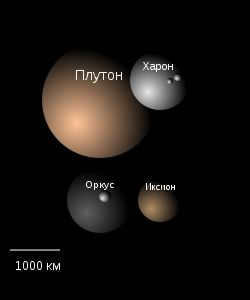

Comparison of large plutinos in terms of size, albedo, and color. (Pluto is depicted alongside Charon, Nycta, and Hydra)
Appearance and Organization
Pluto has an average sidereal magnitude of 15.1, which increases to 13.65 when it is at its closest point to the sun. To observe Pluto, a telescope with an aperture of at least 30 cm is recommended. Even with large telescopes, Pluto appears blurry and star-shaped due to its small angular diameter of only 0.11″. When magnified, Pluto takes on a light brown color with a hint of yellow. Spectroscopic analysis has revealed that over 98% of Pluto’s surface is composed of nitrogen ice, with traces of methane and carbon monoxide. Unfortunately, the distance and limitations of current telescopes prevent us from obtaining high-quality images of Pluto’s surface. The Hubble Space Telescope has provided some photographs, but they only offer limited and unclear details. The best images of Pluto have been created by compiling “brightness maps” using data from eclipses of Pluto by its moon, Charon. By analyzing changes in surface albedo during these eclipses, it is possible to determine the overall average brightness of the Pluto-Charon system and track changes over time. The dark band below Pluto’s equator exhibits a complex coloration, suggesting the presence of unknown mechanisms involved in the formation of Pluto’s surface.
Originally believed to be Lowell’s “Planet X,” astronomers calculated the mass of Pluto based on its estimated impact on the orbits of Neptune and Uranus. In 1955, it was thought that Pluto’s mass was roughly equal to that of Earth, but further calculations in 1971 lowered this estimate to be around the mass of Mars. In 1976, researchers from the University of Hawaii, including Dale Kruikshenk, Carl Pilcher, and David Morrison, calculated Pluto’s albedo and found that it matched the albedo of methane ice. This led to the conclusion that Pluto must be exceptionally bright for its size and therefore could not have a mass greater than 1% of Earth’s mass.
Atmosphere
The atmosphere is the layer of gases that surrounds the Earth. It is composed of various gases, including nitrogen, oxygen, carbon dioxide, and trace amounts of other gases. The atmosphere plays a crucial role in protecting life on Earth by absorbing harmful radiation from the sun, regulating temperature, and providing the necessary gases for respiration. The atmosphere is divided into several layers, including the troposphere, stratosphere, mesosphere, thermosphere, and exosphere. Each layer has its own unique characteristics and functions. Understanding the atmosphere is essential for studying weather patterns, climate change, and the overall health of the planet.
Pluto has a thin layer of nitrogen, methane, and carbon monoxide in its atmosphere, which comes from the ice on its surface. According to thermodynamic principles, the composition of this atmosphere is approximately 99% nitrogen, slightly less than 1% carbon monoxide, and 0.1% methane. As Pluto moves farther away from the Sun, its atmosphere gradually freezes and settles on the surface. Conversely, when Pluto gets closer to the Sun, the temperature near its surface causes the ice to transform into gases through sublimation. This process creates a cooling effect on Pluto’s surface, similar to how sweat cools the body as it evaporates from the skin. Recently, scientists used the Submillimeter Array to determine that Pluto’s surface temperature is 43 K (-230.1 °C), which is 10 K lower than expected. The discovery of Pluto’s atmosphere dates back to 1985 when it was observed obscuring stars. Further observations in 1988 confirmed the presence of an atmosphere by studying the gradual dimming of stars when covered by Pluto.
Orbit
Above is a visualization of the orbits of Pluto (red) and Neptune (blue). It can be observed that Pluto is occasionally situated closer to the Sun than Neptune. The shaded portion of Pluto’s orbit indicates when it is positioned below the ecliptic plane. This data is accurate as of April 2006.
Pluto has a unique orbit compared to the other planets in our solar system. It deviates significantly from the norm, being both highly inclined and eccentric. While the orbits of the other planets are mostly circular and aligned with the ecliptic plane, Pluto stands out with its elliptical path and inclination of more than 17 degrees. Its average distance from the Sun is approximately 5.913 billion km, equivalent to 39.53 astronomical units (a. e.). However, due to its high eccentricity of 0.249, this distance can vary greatly, ranging from 4.425 to 7.375 billion km (29.6-49.3 a. e.). The journey of sunlight from the Sun to Pluto takes approximately five hours, which means that radio waves would require the same amount of time to reach a spacecraft near Pluto from Earth. Interestingly, the eccentricity of Pluto’s orbit causes a portion of it to come closer to the Sun than Neptune, a rare occurrence. The last time Pluto occupied this position was from February 7, 1979, to February 11, 1999. Calculations reveal that prior to that, Pluto was in this position for a brief period from July 11, 1735, to September 15, 1749, spanning only 14 years. Going further back, from April 30, 1483, to July 23, 1503, Pluto held this position for a longer period of 20 years. The inclination of Pluto’s orbit to the ecliptic plane ensures that its path never crosses with that of Neptune. As Pluto reaches its perihelion, it is situated 10 a. e. above the ecliptic plane. In addition, Pluto has an orbital period of approximately 247.69 years, completing two revolutions while Neptune completes three. Consequently, Pluto and Neptune never come closer to each other than 17 a. e. The trajectory of Pluto’s orbit can be predicted for millions of years in either direction, but not beyond. The mechanical motion of Pluto is characterized as chaotic and described by nonlinear equations. However, observing this chaos requires a significant amount of time. There is a specific developmental time known as the Lyapunov time, which for Pluto is estimated to be 10-20 million years. When observed over shorter periods, the motion appears regular and follows an elliptical pattern. Nevertheless, the orbit gradually shifts with each period, and over the course of the Lyapunov time, the original orbit is completely altered. This is why modeling Pluto’s motion is extremely challenging.
In May 1930, the International Astronomical Union awarded Pluto with the designation of a planet (at that point, it was believed that Pluto was similar to Earth). Nevertheless, the status of Pluto has been subject to scrutiny since the discovery of the first Kuiper Belt object, 1992 QB1 (also known as 15760), in 1992. The ongoing discoveries of additional Kuiper Belt objects have only served to further fuel the ongoing debate.
Pluto’s Status as a Planet
The plaques included on the Pioneer 10 and Pioneer 11 spacecrafts in the early 1970s still refer to Pluto as one of the planets in our solar system. These specially crafted aluminum plaques, which were sent along with the spacecrafts into deep space with the hope that they would be discovered by extraterrestrial civilizations, were designed to provide them with information about the nine planets in our solar system. Similarly, the Voyager 1 and Voyager 2 spacecrafts, which were also launched in the 1970s with a similar purpose, also carried information about Pluto as the ninth planet in our solar system. Interestingly, the beloved Disney cartoon character Pluto, who made his debut on screens in 1930, was actually named after this celestial body.
In 1943, Glenn Seaborg decided to call the recently discovered element plutonium, which he had created, after the planet Pluto. This was in line with the established practice of naming newly discovered elements after recently discovered planets. For example, uranium was named after Uranus, neptunium after Neptune, cerium after the minor planet Ceres, and palladium after the minor planet Palladus.
Is this the final verdict on the fate of Pluto?
The International Astronomical Union (IAU) has made a decision at a meeting in Oslo to now classify dwarf planets like Pluto as “plutoids”. It has been almost two years since the IAU General Assembly, during which Pluto was removed from the list of proper planets and the term “dwarf planet” was introduced for objects like Pluto that are located beyond Neptune. The term “plutoid” was suggested by members of the IAU Committee on Small Bodies Nomenclature (CSBN).
Plutoids are celestial bodies that orbit the Sun at a distance greater than Neptune’s orbit and have enough mass to maintain a rounded shape due to their own gravitational forces. However, they do not have the ability to clear space from other objects and dominate their orbit.
The two currently known plutoids are Pluto itself and Erida. It is expected that the number of plutoids will increase in the future, particularly when the New Horizons mission reaches the Kuiper belt in 2015.
There is a possibility that the dwarf planet Ceres could be classified as a plutoid since it is located in the asteroid belt between Mars and Jupiter. It is believed that Ceres is one of these asteroids, particularly because it is the largest. However, at this time, there has not been a separate category proposed for Ceres-like dwarf planets.
Since the early 1900s, the IAU has been responsible for naming planets and their satellites. The IAU CSBN, the organization that originally introduced the term plutoid, is in charge of naming small bodies in the solar system (excluding satellites and dwarf planets). During discussions in Oslo, IAU members also considered the criteria for designating plutoid status. It was determined that only solar system bodies meeting the following conditions would be classified as plutoids:





